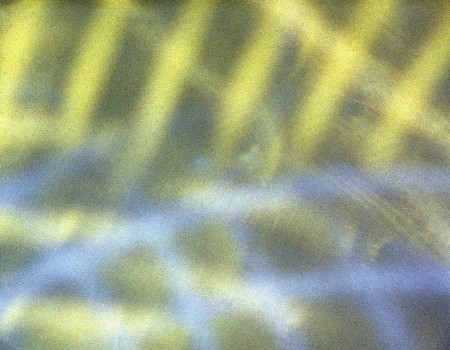The School of the Art Institute of Chicago’s F Newsmagazine sits down with Joost Rekveld, Dutch filmmaker and current head of the ArtScience Interfaculty in The Hague. Read the full story in the October edition of F News.
F News: In terms of the film work, who would you credit as your influences?
Joost Rekveld: I was triggered to make abstract films by Oskar Fischinger. Also, post-war American abstract films like James Whitney, Jordan Belson, Stan Brahkage. The whole tradition of visual music was very important to me. But the idea of visual music has become less the focus in recent years.
F News: I’m curious about the role that music plays in your work. Are the visuals stimulated by the music, or is the music typically written after the film is completed?
JR: I’m not primarily interested in combining images and sounds, but there are many connections on a higher level, since I see myself as a composer of moving images. My approach is to make a score, and then based on the score I make the imagery. For a while, my dream was to make my own films and my own electronic music. At some point I realized I like electronic music, but I didn’t necessarily like to make it.
Now, I often ask a composer I know to score a film, or I get asked by a composer or theater director to collaborate in a project.
F News: How much direction do you give the composers you work with, and how much artistic liberty do you give them?
JR: We always tend to find common ground in the sense that in the sound, they address the same concepts which inform the images. This method is more about finding a common approach. I choose to work with people I can relate to.
F News: It struck me that some of the films could function very easily as backdrops for performances — particularly live electronic music performances.
JR: I have done work with theater and dance companies where I do images in real-time. In terms of working with electronic musicians in a live setting, it would be logical to do, but I haven’t gotten around to it (laughs). About six years ago, I began working with software. Before, I made mechanical machines to show images. I never really worked to make something sturdy and versatile enough to perform within a live setting. In recent years, I have started to use software for more things, and that made it easier to do things in real-time too. [For the software] I use Jitter, and Max MSP…[Mac MSP] is software which was developed mostly for electronic musicians. About seven years ago they added a visual component.
F News: Your work is informed by rigorous academic research, and your use of technology is also interesting. Yet, there doesn’t seem to be any clear indication of either in the work itself.
JR: It’s very easy to talk about the work in technical terms, in terms of the research and concepts that inform it. In the end, what’s most important is the sensual experience. Also when you hear composers talking about their work, they never talk about the experience of listening to the piece, but always about the things which are more easy to talk about…In a way, what I find really important in my work is that all of this technology or science, it’s also a product of human culture. The first human is a monkey which discovers a tool. Often, technology is seen as this strange alien thing invading our lives, and yet it is also is what defines us as human. Part of what I’m trying to do is to humanize this thing, make the principles behind some of it accessible to our senses and show its poetic quality.
F News: What are some of the things that have informed your work?
JR: For the film #23.2, Book of Mirrors, I was very inspired by the history of optics, and medieval approaches and explorations of perspective. It was determined at the beginning of the 17th century that when light goes through a very small hole, you get interference patterns produced by the light waves. I decided I wanted to make a film using this principle. So I built a machine. It’s a big black box with a rail that has these units. These units have patterns of tiny slits. There is a hole in the box for light to enter. The light source travels through these slits and holes, and then the light oozes directly onto the emulsion of the film. I was interested in what kind of images this would produce, [and whether or not] you’d get a sense of space that is different to the standard perspective space that is inherent in standard optics.
F News: And you are teaching at the Hague?
JR: For a year and a half, I am the head of the department of the ArtScience Interfaculty of the Royal Academy of Art and the Royal Conservatoire in The Hague. It sounds horribly pretentious, and people usually think it’s much more about science than it is art. But it’s a name that is starting to resonate with people, and I do think it points to something that is essential and which has the potential to be very cool. While in a bookstore in Ann Arbor, by total accident I found this book that was also called ArtScience, written by David Edwards, a writer and biologist at Harvard. It’s actually a really interesting book that defines ArtScience as the grey area between the two fields where most innovation happens. [Edwards] has many interesting examples of, say, artists who decide they’d rather study physics than art. I can totally relate to that.
